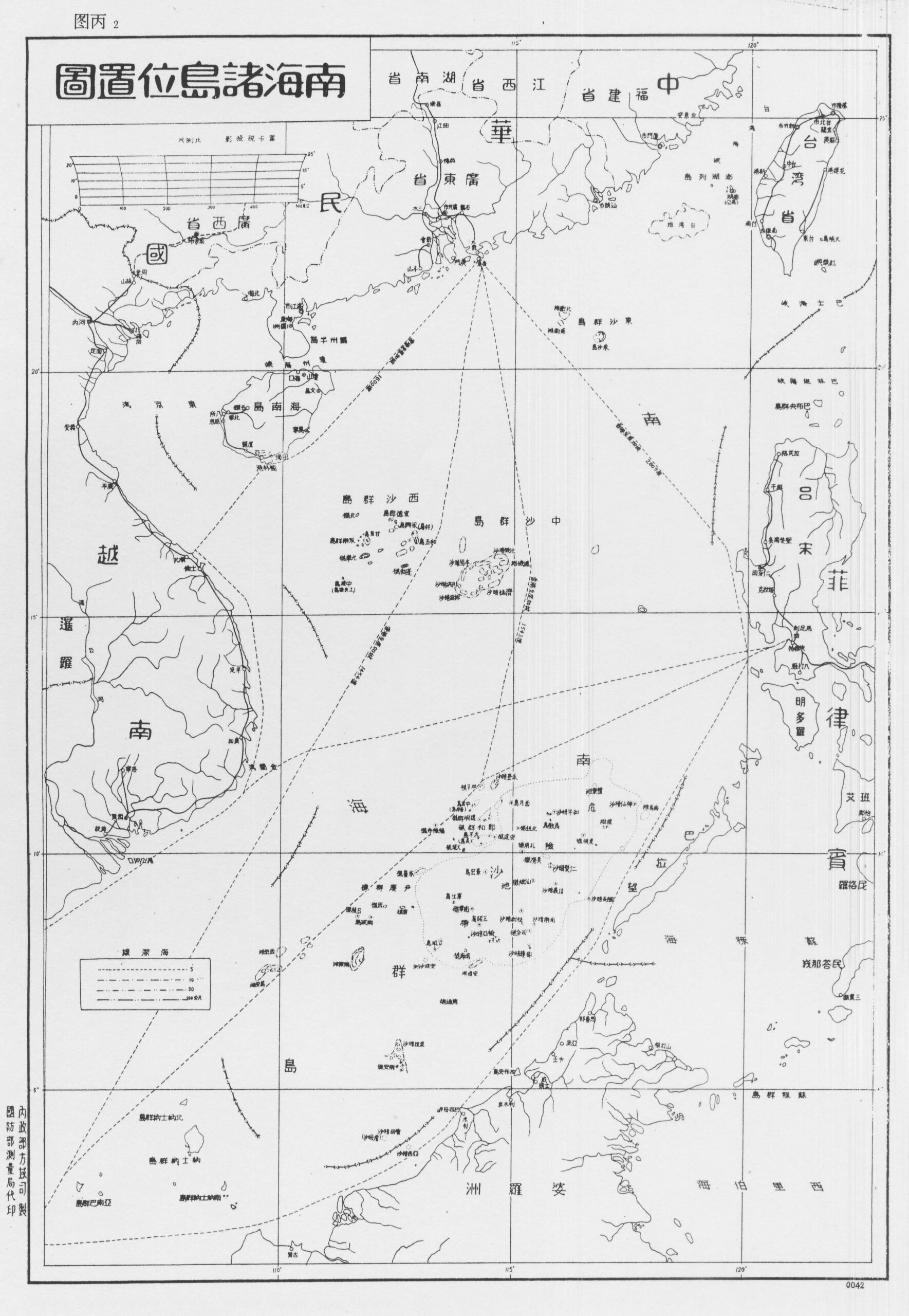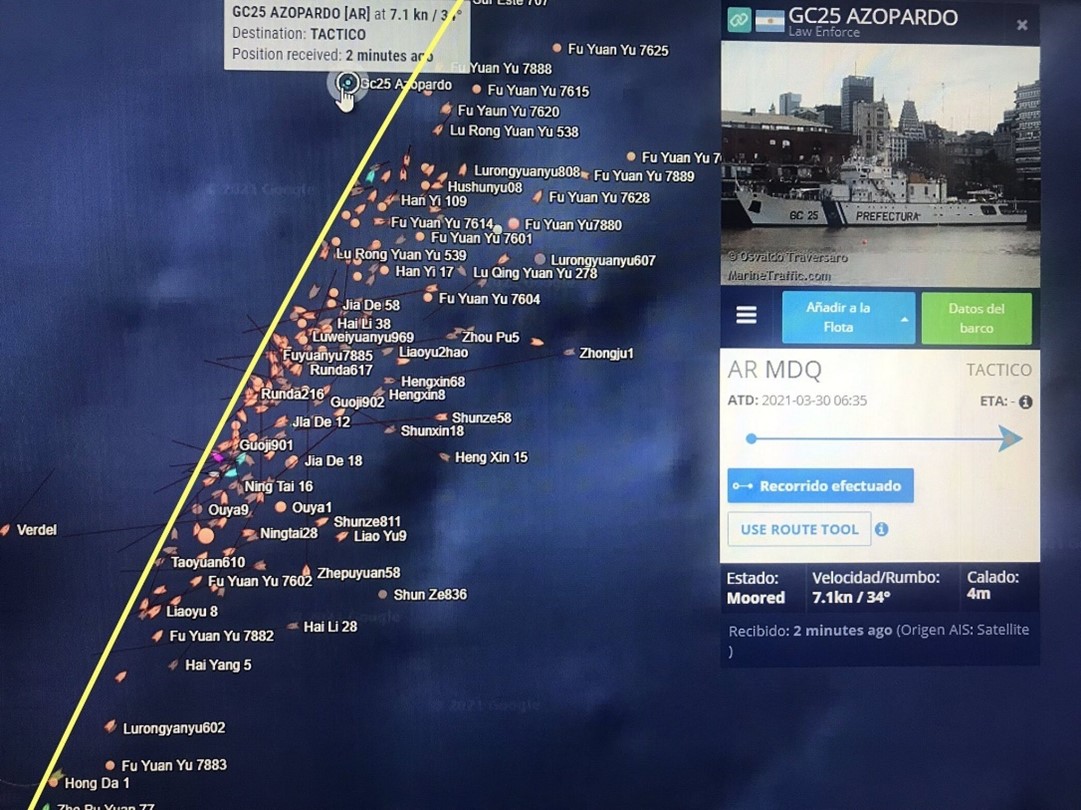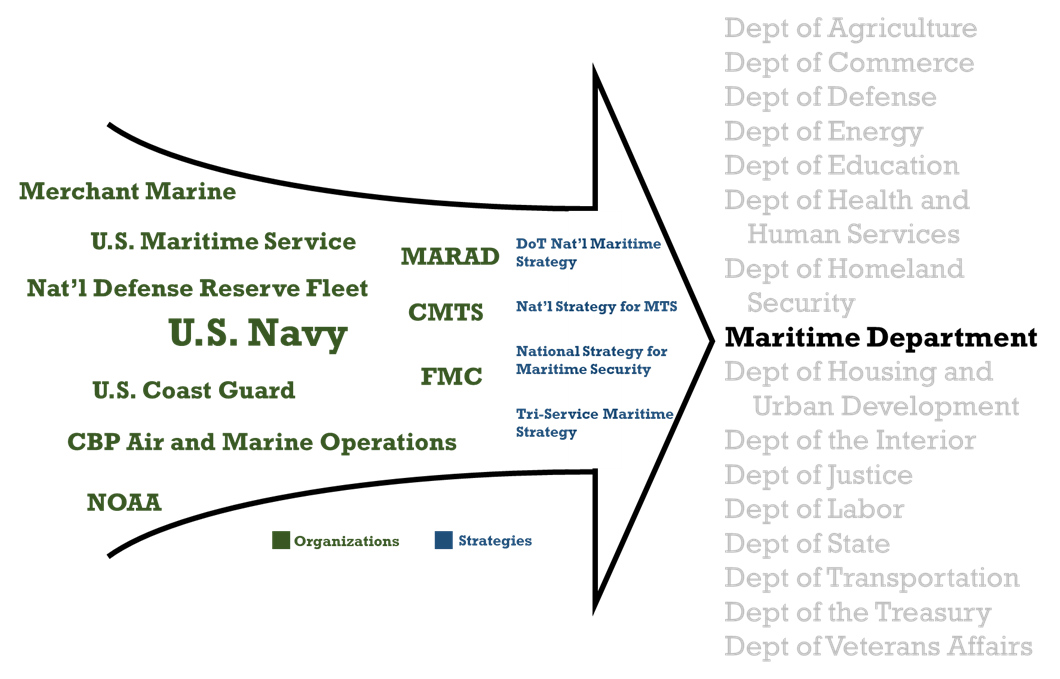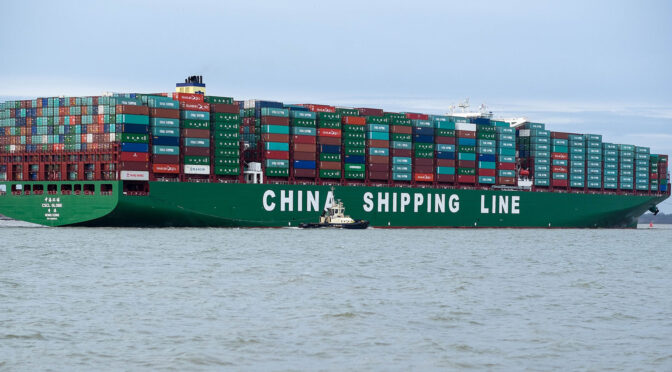By Jimmy Drennan
The ongoing supply chain crisis is a sobering reminder that American maritime interests have always been about more than national defense. The U.S. Coast Guard traces its lineage to an 18th century Treasury Department service charged with tariff enforcement. Over time, its mission evolved and expanded, while the U.S. built the world’s foremost Navy and formed myriad other agencies to secure its broad maritime interests. In the 21st century, China’s ambitious bid to reinvent the way a nation can exploit the high seas and define multifaceted maritime interests has emerged as a tangible threat to America’s future. This threat demands a new approach to maritime security and prosperity.
In the next decade, the balance between the U.S. and People’s Liberation Army (PLA) Navies will be pivotal in defending the concept of freedom of the seas, likely without even firing a shot. Throughout its history, the U.S. Navy has ranged from six to 6,768 ships. By most estimates, the current fleet of 299 battle force ships is about 100-200 short of what America needs to secure its national interests, and navalists are dusting off old theories to convince Congress of the value of seapower.
From Barbary Pirates to the Great White Fleet, or to strategic confrontation with the Soviet Union, the U.S. Navy has been integral not only in ensuring America’s security in wartime, but also its prosperity in peacetime. The 2020 U.S. Tri-Service Maritime Strategy1 echoes 19th century strategist Alfred Thayer Mahan when it states that the naval service’s peacetime missions include “safeguarding global commerce” and “extending American influence.”2 In fact, Mahan’s philosophy even suggests that navies serve a primarily economic purpose. If the U.S. Navy’s mission goes beyond national defense, it is unlikely to be adequately resourced in a parent department that seeks to equitably distribute funds across all other military branches. Meanwhile, China’s recent naval buildup – tripling to around 360 battle force ships in the last 20 years – is possibly not meant to defeat America in a war at sea, but to serve as a credible deterrent force to underwrite the various economic and coercive aspects of its maritime strategy.
America should reconceive how it leverages and secures its territorial waters, trade routes, and the high seas. The history of America’s tangled maritime bureaucracy offers insight to how it can answer China’s challenge.
From Cutters to Committees: America’s Maritime Heritage
As the Navy steadily cemented its role as the primary guarantor of America’s maritime interests, other federal maritime entities grew and evolved, primarily through two institutions: the Coast Guard and the Merchant Marine.
The U.S. Coast Guard
Long before the United States commanded the world’s largest Navy, America’s leaders recognized the sea as the lifeblood of its economic prosperity. Following the Revolutionary War, the national debt topped $75 million ($2.16 billion in today’s dollars), and import duties on seaborne trade represented the bulk of federal revenue. On August 4th, 1790, Secretary of the Treasury Alexander Hamilton convinced Congress to commission ten cutters and establish the Revenue-Marine to enforce its tariffs. Hamilton understood the danger of lost revenue from smuggling and piracy, writing to the service’s commanding officers: “It is well known that one of the most extensive cases of illicit trade is that which is here intended to be guarded against – that of unlading goods before the arrival of a vessel into port, in coasters and other small vessels, which convey them clandestinely to land.” For example, in 1756 and 1757, only 16 of 400 chests of tea were imported legally into Philadelphia. In 1763 the British government estimated £700,000 in goods were smuggled into the colonies annually, which equates to about $150 million today. Even a fraction of that loss of revenue would have been devastating to the newly independent nation.
Congress merged the Revenue-Marine (then termed the U.S. Revenue Cutter Service) and U.S. Lifesaving Service in 1915 to establish the Coast Guard as a branch of the armed forces. The Coast Guard would integrate operations with the Navy as economic and military threats overlapped, formally shifting to the Navy Department when Congress declared war in 1917 and 1941. As the Coast Guard assumed other military and navigation support missions, its relationship with Treasury gradually faded. The U.S. Customs Service was originally tasked to oversee the cutter fleet in 1789. The two services jointly collected and enforced the nation’s tariffs, but by the early 20th century, the Customs Service’s border patrol primarily performed these roles. The Coast Guard no longer protected federal revenue when it transferred to the new Department of Transportation (DoT) in 1967. In response to the 9/11 terrorist attacks, the 2002 Homeland Security Act moved the Coast Guard under the new Department of Homeland Security (DHS), for which maritime border security would be a core mission. The Act also rejoined the Coast Guard with customs but kept their functions separate, creating Customs and Border Protection (CBP) and Immigration and Customs Enforcement (ICE) under DHS. In fact, under the reorganization, ICE, and later CBP, maintained an Air and Marine Operations division tasked with securing the nation’s maritime borders, which perpetuated bureaucratic fragmentation.
To this day, DHS frames its maritime security mission from a post-9/11 “Global War on Terrorism” perspective. The National Strategy for Maritime Security (NSMS), jointly developed by DHS and the Department of Defense (DoD) in 2004 to better coordinate all federal maritime security efforts, states: “Preeminent among our national security priorities is to take all necessary steps to prevent [weapons of mass destruction] from entering the country and to avert an attack on the homeland.”3 The strategy, which has not been updated, does not fathom the rise of China. It anchors all threats, including theoretical conflict between unspecified major powers, to the potential for terrorist attacks on the homeland.
The U.S. Merchant Marine
Just as in Hamilton’s time, the U.S. still depends on the sea for its economic health, with over 70 percent of foreign trade, worth more than $1.5 trillion, flowing through the nation’s seaports.4 Modern federal oversight of maritime trade is rooted in the 1916 U.S. Shipping Board, which Congress tasked with boosting American shipping capacity and addressing overreliance on foreign carriers. At the time, about 10 percent of U.S. trade was carried in U.S.-flagged ships.5 Today, that number is less than two percent. In 1933, after successfully supporting the American war effort, the Shipping Board was moved under the Department of Commerce and eventually replaced by the independent U.S. Maritime Commission by the Merchant Marine Act of 1936, in part to “promote the commerce of the United States, [and] to aid in the national defense.” In 1950, the commission disbanded and its duties were split between the new Maritime Administration (MARAD) and Federal Maritime Board, both under the Department of Commerce. The Federal Maritime Board became the independent Federal Maritime Commission in 1961, and MARAD transferred to DoT in 1981.

In 2004, the Secretary of Transportation chaired the new Committee on the Marine Transportation System (CMTS) to secure and improve America’s infrastructure network of over 8,000 facilities and 25,000 navigable waterways.6 The CMTS maintains a five-year National Strategy for the MTS, last published in 2017. That same year, DoT submitted a separate draft national maritime strategy, which Congress directed in 2014 to make the U.S. maritime industry more competitive. DoT finally released the strategy in 2020 after years of bureaucratic delay (Figure 1).7 The red tape did not stop there. Two additional interagency committees developed national strategies for mapping the 2.25 million square mile U.S. economic exclusion zone (EEZ) and establishing maritime domain awareness.8 Furthermore, the Coast Guard shares responsibility for enforcing fisheries laws in the EEZ with the National Marine Fisheries Service, an element of the National Oceanographic and Atmospheric Administration (NOAA) within the Department of Commerce.9
The Merchant Marine Act of 1936 also spawned the U.S. Maritime Service (USMS) to train citizens to serve in the U.S. Merchant Marine, the collective fleet of federally and civilian owned merchant vessels. Over time, authority over the USMS shifted between the U.S. Maritime Commission, the Coast Guard, and DoT. Despite its vital role in Allied victory, the service’s various activities were absorbed by other federal agencies following World War II, while the Secretary of Transportation retained a symbolic cadre of USMS officers.
Today, the U.S. Merchant Marine fleet is administered by a combination of the Navy, MARAD, and private industry. That fleet is obsolete and dwindling. As of 2018, the U.S. owned one percent of the world’s container ship fleet, with an average ship age of 20 years, compared to China and Hong Kong which owned 18 percent with an average age of 10 years.10 U.S.-flagged merchants currently represent 0.4 percent of the world fleet, compared to over 40 percent in 1947. The National Defense Reserve Fleet, a subset of the Merchant Marine, has shrunk to 88 federally-owned merchant vessels maintained to support shipping during national emergencies, down from its peak of 2,277 in 1950.
If current trends persist, the U.S. will increasingly rely on Chinese infrastructure for its seaborne trade and transport, reminiscent of the conditions that led to establishment of the U.S. Shipping Board in the first place.
The Chinese Maritime Challenge
As American maritime bureaucracy meandered, Chinese challenges to the post-World War II international order coalesced. Rather than use the PLA Navy and land-based power projection alone to exercise traditional sea control, the People’s Republic of China (PRC) has used the world’s oceans innovatively as part of an economic gray zone strategy11 to intimidate its neighbors and encroach on their sovereignty, undermine customary law of the sea, and avoid open confrontation with the U.S. and allied navies along the way.
From its inception in 1949, the PRC established two key elements of its maritime strategy: the Nine-Dash Line, which mapped Beijing’s claim of sovereignty over the vast majority of the South China Sea (Figure 2); and the Maritime Militia, a loosely controlled fleet of freighters, tankers, and fishing vessels to assist the small PLA Navy in its struggle to prevent Nationalist incursions into mainland China’s territorial waters. China generally followed international maritime norms in the 20th century, ratifying the UN Convention on the Law of the Sea (UNCLOS) in 1996, but now flouts the prescribed definitions of territorial waters and EEZs in favor of the Nine-Dash Line. Meanwhile, as China’s maritime ambitions grew, the Maritime Militia gained prominence in Chinese doctrine for asserting its sovereignty, sometimes amassing hundreds of militia vessels inside the EEZs of neighboring nations.

A strategic cousin of the Maritime Militia is China’s Distant-Water Fishing (DWF) fleet. In 1985, China had 13 DWF vessels. Today, as many as 17,000 Chinese vessels, far more than any other nation’s fleet, harvest the world’s fisheries, sometimes illegally, to sell their catch at home and abroad.12 China’s growing appetite for fish – forecasted to create a 6-18 million ton domestic shortage by 2030 – will increasingly pressure its DWF fleet to fish inside other nations’ EEZs, with or without their consent.13 Globally, illegal, unreported, and unregulated fishing accounts for up to $50 billion in lost revenue, and China’s DWF fleet is a growing flashpoint for conflict, particularly as other Asian nations assert their sovereignty in the South China Sea.14 Yet, this is not a problem that the world’s navies alone can address. Although it pushes the envelope on fishing regulations, China seems to set policies for its DWF fleet that comply with internationally accepted standards, such as lining up hundreds of vessels one mile outside a nation’s EEZ (Figure 3). Most nations, including the U.S., are simply unwilling to use military force against fishermen not violating their sovereignty or international law.

The Belt and Road Initiative (BRI), China’s multi-trillion-dollar global infrastructure strategy, seeks to tilt the global economy in Beijing’s favor. Chinese state-owned firms already operate, or hold majority stakes in, the ports of Piraeus, Greece; Haifa, Israel; Gwadar, Pakistan; and Hambantota, Sri Lanka.15 China may or may not try to convert these ports to overseas naval bases, like the one it maintains in Djibouti near the mouth of the Red Sea. Still, one can easily see how leverage over trading partners and logistics hubs could threaten American prosperity in a global economy so heavily dependent on seaborne trade. The 2021 supply chain crisis offers a clear example of what can happen when key links in the chain are unavailable. In addition to owning the world’s largest nationally-flagged merchant fleet by a wide margin, China builds half of the world’s new container ships, and its state-owned shipping firm COSCO is the world’s largest terminal operator, accounting for 14 percent of the world’s container throughput.16 Certain elements of BRI also have maritime implications, such as the Polar Silk Road, which would cut China’s transit distance to Europe by 24 percent using Russia’s Northern Sea Route, and the Digital Silk Road, into which China has invested $79 billion in countries like India, Mexico, and the Philippines to build undersea internet cables and a navigation satellite network.17,18
The U.S. Maritime Department
If China stays in the gray zone and avoids military confrontation, the U.S. will struggle to secure its maritime interests with any number of warships under its current federal structure. In 2007, the U.S. Naval Studies Board formed a committee on the “1,000-Ship Navy” to study the Chief of Naval Operations’ vision of global maritime partnerships. The Committee observed that there is “no single agency or department that can effectively speak for the President and the nation’s maritime concerns. Responsibilities are fragmented. Authority is often exercised but decisions are not coordinated, so the result is less than optimal.” The Committee concluded that a “novel and extraordinary approach is needed to break through the international barriers abroad and interagency barriers at home,” recommending three potential alternatives: improve interagency coordination under existing federal government structure, assign a lead agency, or establish a new agency either under an existing department or standalone (like the Federal Aviation Administration).19 The Committee’s findings have proven prescient, but the recommendations fell short of addressing the economic and diplomatic challenge that China would pose.
Perhaps with the benefit of foresight, the Committee would have made a fourth recommendation: establish a cabinet-level Maritime Department with a mission of integrating applications of national power to ensure maritime security and prosperity.

Without bold federal realignment, it is difficult to see how a nation with no less than four independent national maritime strategies can achieve maritime security and prosperity. Before it can even address strategy, the U.S. must learn from history and restructure itself to meet contemporary challenges. In addition to the Bush Administration’s creation of DHS in the wake of 9/11, President Carter created the Department of Energy following the 1973 oil crisis, and President Truman created DoD in 1947 due to military dysfunction after World War II. A Maritime Department would integrate national power in the maritime domain by consolidating the various federal entities responsible for maritime security and prosperity, to include the Coast Guard, MARAD, NOAA, and others (Figure 4). To solve the dilemma of having to adequately resource the Navy’s peacetime missions while maintaining readiness to win the nation’s wars at sea, the Navy may also need to be transferred from DoD, except during a state of war or when supporting Combatant Commanders in overseas contingency operations.
This arrangement is analogous to the current relationship between the Coast Guard and DoD. The notional Maritime Secretary would advocate for the value of American seapower from the perspective of all of its maritime interests, not just national defense. Granted, creating a Maritime Department would not automatically boost much needed funding for the sea services and other maritime entities, but it would enable greater budget flexibility between the Navy, Coast Guard, and Merchant Marine, essentially pooling their resources to more effectively integrate national security, law enforcement, and commercial activities.
The Two Sides of the Pacific
The contrast between American and Chinese strategic momentum at sea is stark. China’s activities at sea are well integrated facets of a national strategy in full execution, while America’s federal maritime entities progress haphazardly. Prevailing in modern maritime competition requires more than warships and, in any case, America’s heritage of seapower has never been about national defense alone. The Navy is the most capable maritime arm of the U.S. government, but its capacity is being overwhelmed by competing demands to support current military campaigns, prepare for future conflict, and counter China in the gray zone.
Even after properly funding the Navy, the prospect for American maritime interests under the current federal structure is bleak. A focus on military readiness for a conflict that may never come may cause America to sit out of the strategic competition entirely, never clearly seeing China’s national strategy nor developing one of its own. The authors of the “1,000 Ship Navy” report predicted the need for a novel and extraordinary approach to overcome the “quagmire of bureaucratic and political hurdles” they saw, even before seeing the threat China would pose to America’s security and prosperity.20 After 14 years of strategic stagnation on one side of the Pacific and stunning acceleration on the other, the hurdles are even higher. In another 14 years, they may be insurmountable.
References
1. The governing strategic document for the U.S. Navy, Marine Corps, and Coast Guard (collectively, the “naval service”).
2. Braithwaite, Kenneth J., Advantage at Sea: Prevailing with Integrated All-Domain Naval Power, 16 December 2020 (Washington, DC: Department of the Navy, 2020)
3. United States White House Office, The National Strategy for Maritime Security, September 2005, retrieved from https://www.hsdl.org/?abstract&did=456414, 30 May 2021. The NSMS is separate from the Tri-Service Maritime Strategy.
4. U.S. Committee on the MTS, National Strategy for the MTS: Channeling the Maritime Advantage, 2017-2022. (Washington, DC, 2017), p. 4.
5. Hurley, Edward N., The Bridge to France. (Philadelphia & London: J. B. Lippincott Company, 1927).
6. U.S. Committee on the MTS, National Strategy for the MTS: Channeling the Maritime Advantage, 2017-2022. (Washington, DC, 2017), p. 15.
7. United States Government Accountability Office, Report to Congressional Committees on National Maritime Strategy: DOT Is Taking Steps to Obtain Interagency Input and Finalize Strategy. (Washington, DC: GAO, 2020).
8. In 2020, the Ocean Science and Technology Subcommittee of the Ocean Policy Committee, led by NOAA, published a national strategy for mapping, exploring, and characterizing the U.S. EEZ. Separately, the U.S. National MDA Plan is maintained by an executive steering committee consisting of representatives from the National Maritime Intelligence-Integration Office (NMIO) and the Departments of Defense, Homeland Security, and Transportation – but excludes NOAA and the Department of Commerce.
9. Garofolo, John, “Protecting America’s Fisheries,” Coast Guard. (Washington, DC: USCG, 1998).
10. United Nations Conference on Trade and Development, Review of Maritime Transport 2018 (New York: United Nations Publications, 2018).
11. International political competition below the threshold of armed conflict.
12. Gutierrez, Miren, Daniels, Alfonso, Jobbins, Guy, Gutierrez Almazor, Guillermo, Montenegro, Cesar, China’s Distant-water fishing fleet: Scale, impact and governance, ODI Report, June 2020.
13. Crona, B., Wassénius, E., Troell, M., Barclay, K., Mallory, T. et.al., China at a Crossroads: An Analysis of China’s Changing Seafood Production and Consumption, One Earth, Perspective, Vol. 3, Issue 1, pp. 32-44, 24 July 2020.
14. Sumaila, U. R., Zeller, D., Hood, L., Palomares, M. L. D., Li, Y., Pauly, D., Illicit trade in marine fish catch and its effects on ecosystems and people worldwide, Science Advances, Vol. 6, No. 9, 26 February 2020.
15. Hillman, Jennifer, Sacks, David, China’s Belt and Road: Implications for the United States, Council on Foreign Relations, Independent Task Force Report No. 79, March 2021.
16. United Nations Conference on Trade and Development, Review of Maritime Transport 2019 (New York: United Nations Publications, 2019).
17. Albert Buixadé Farré, Scott R. Stephenson, Linling Chen, Michael Czub, Ying Dai, Denis Demchev, Yaroslav Efimov, Piotr Graczyk, Henrik Grythe, Kathrin Keil, Niku Kivekäs, Naresh Kumar, Nengye Liu, Igor Matelenok, Mari Myksvoll, Derek O’Leary, Julia Olsen, Sachin Pavithran.A.P., Edward Petersen, Andreas Raspotnik, Ivan Ryzhov, Jan Solski, Lingling Suo, Caroline Troein, Vilena Valeeva, Jaap van Rijckevorsel & Jonathan Wighting, Commercial Arctic shipping through the Northeast Passage: routes, resources, governance, technology, and infrastructure, Polar Geography, 37:4, 298-324, 2014.
18. Deloitte, BRI Update 2019 – recalibration and new opportunities (Shanghai: Deloitte, 2019).
19. National Research Council, Maritime Security Partnerships (Washington, DC: The National Academies Press, 2008).
20. National Research Council, Maritime Security Partnerships (Washington, DC: The National Academies Press, 2008).
Featured Image: Arlington (LPD-24) on the builders ways at Northrop Grumman Ship Systems, Ingalls Operation, Pascagoula, MS. (Photo via NavSource)



